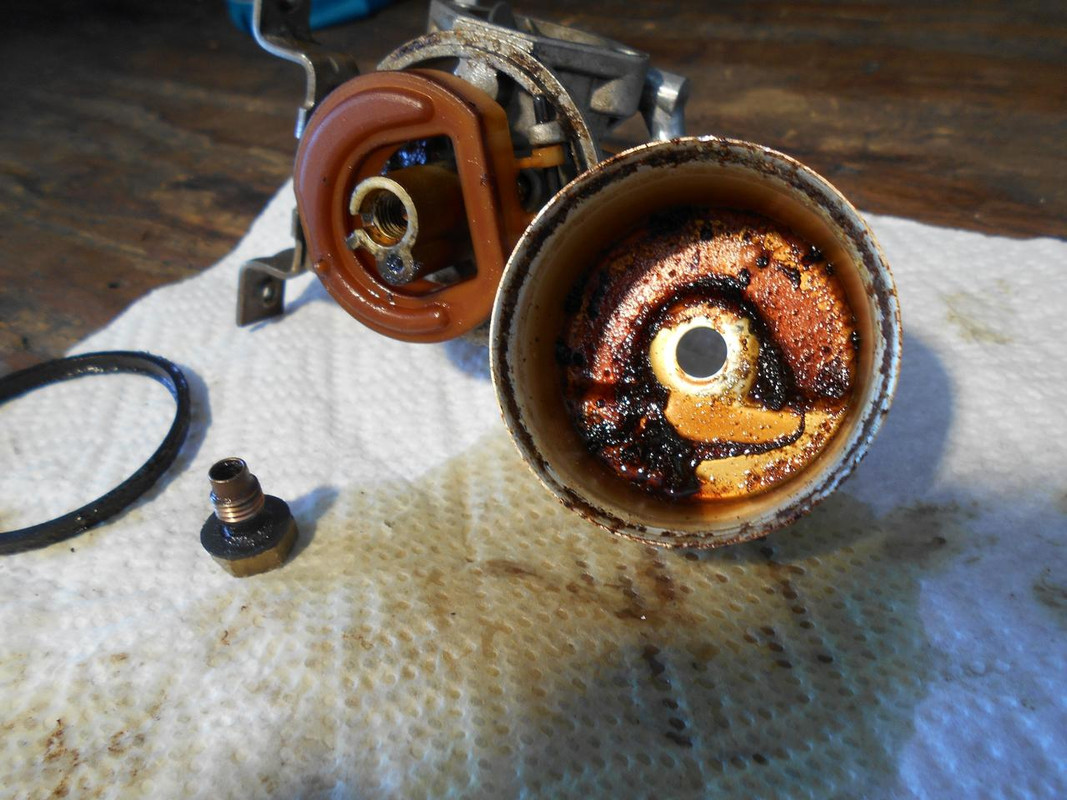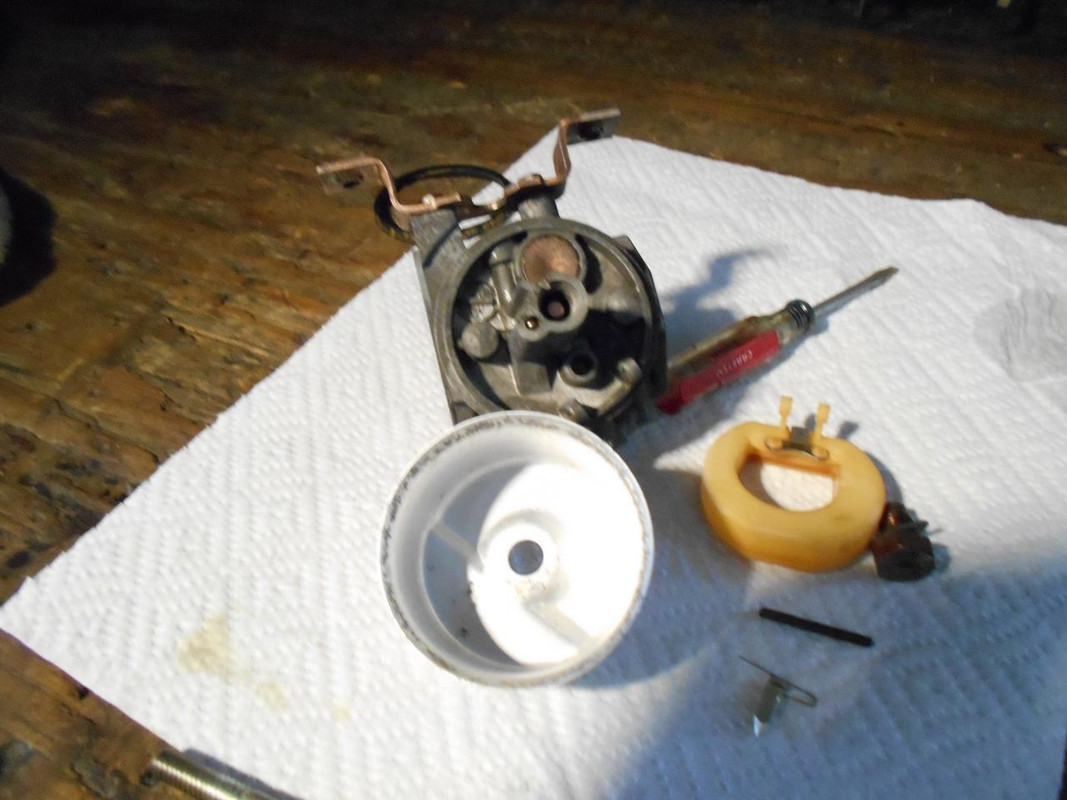- Joined
- May 6, 2014
- Messages
- 1,978
- Reaction score
- 1,927
- Points
- 113
- Location
- Amoungst the Twisty Roads
You can't have too many projects...all at the same time no less. But this one might benefit or inspire some of you.
I have brought a lot of motorcycles back from the dead over the years. Without a doubt, the most labor intensive part of these restorations is the cleaning & restoration of metal parts. I hate it, and it probably keeps me from doing more projects. With my current CB900 project - that needs a lot of metal restoration - I'm gonna get serious about restoration equipment. The first piece of equipment I purchased is a Ultrasonic cleaner. I got a large 10 litter unit so I can submerge fairly large items (the basket is 11 x 8 x 4). The trick to using these units is to put the item to be cleaned in a plastic jar (like a big peanut butter jar) or ziplock baggie. This way you don't have to constantly empty the cleaning fluid from the unit. The dirty cleaning solution is limited and contained in the smaller container. The ultrasonic cleaner will be perfect for nuts and bolts, and washing parts like carburetors and master cylinders. But bigger parts will require some force.
The next piece of equipment is the DIY project. I've been planning this one for weeks, and today I made all of my purchases. I'm going to build a vapor blasting (aka wet media or vapor honing) cabinet. This is not my own design, but my interpretation of what I have seen on youtube. This cabinet should reduce the labor involved to clean dirty and oxidized parts (like an engine case cover) from 2-4 hours to about 15-20 minutes - with better results. Here's the parts list and prices:
Harbor Freight Blasting Cabinet (it's gonna be converted/modified) @$179 (on sale this week)
1.5hp Sewage Pump/4300 gph @$90 eBay
Sandblasting Nozzle @$35 eBay
6 gallon bucket @$15 Amazon
3/8 Check Valve @$20 Amazon
Dragway Tools Pneumatic Foot Pedal Switch @$65 Amazon
Assorted hoses & fittings @$40 Lowes
Total investment about $450.
Not included is the cost of an air compressor - which I already have. I have a 3.25hp 60 gallon Cambell Hausfeld unit that has a max out put of 135psi, with flows of 11.5cfm@40psi and 10.2cfm@90psi. We will come back to this because I have a question for those of you that know air compressors.
The media used in these systems is 175-325 grit glass beads, shot at 60 psi. The system is closed loop so I don't need a fresh water supply at the cabinet. Here is the basic theory of operation:
The sewage pump will be placed in the 6 gallon bucket along with 4 gallons of water and about a pound of media. The output from the pump will be split; with 1/2 of the output used in the cabinet as a blasting media and the other 1/2 will remain in the bucket to agitate/mix the media with the water (the "slurry"). The slurry will be mixed at the nozzle with air from the compressor. The used slurry will fall to the bottom of the media cabinet that has a 4x4 opening at the bottom, and then fall into the bucket (with the motor) sitting below the opening. The slurry will be recycled back into the bucket and back through the pump.
Pretty simple, right?
I'll get photos of the parts as they come in and as they go together with details on any modifications.
OK, here's my question that I can't seem to get my head around. My compressor is plumbed with 3/8 hosing and 3/8 NPT quick connects. The ID of 3/8 hosing is usually a bit less than .375", around .340". OK. The quick disconnects I use have an ID of .190". These are the typical QD found...everywhere. Are there quick disconnects for 3/8 hosing that have a larger opening? I could direct plumb the air lines right to the nozzle using barbs - but QD do make life easier. Also, I notice a lot of people building these cabinets use 1/2 line to get the maximum CFM @ 60psi, but the foot switch is 3/8 NPT - so what's the point of converting to 1/2 lines? The foot switch will always be the restriction. What am I missing here?
I have brought a lot of motorcycles back from the dead over the years. Without a doubt, the most labor intensive part of these restorations is the cleaning & restoration of metal parts. I hate it, and it probably keeps me from doing more projects. With my current CB900 project - that needs a lot of metal restoration - I'm gonna get serious about restoration equipment. The first piece of equipment I purchased is a Ultrasonic cleaner. I got a large 10 litter unit so I can submerge fairly large items (the basket is 11 x 8 x 4). The trick to using these units is to put the item to be cleaned in a plastic jar (like a big peanut butter jar) or ziplock baggie. This way you don't have to constantly empty the cleaning fluid from the unit. The dirty cleaning solution is limited and contained in the smaller container. The ultrasonic cleaner will be perfect for nuts and bolts, and washing parts like carburetors and master cylinders. But bigger parts will require some force.
The next piece of equipment is the DIY project. I've been planning this one for weeks, and today I made all of my purchases. I'm going to build a vapor blasting (aka wet media or vapor honing) cabinet. This is not my own design, but my interpretation of what I have seen on youtube. This cabinet should reduce the labor involved to clean dirty and oxidized parts (like an engine case cover) from 2-4 hours to about 15-20 minutes - with better results. Here's the parts list and prices:
Harbor Freight Blasting Cabinet (it's gonna be converted/modified) @$179 (on sale this week)
1.5hp Sewage Pump/4300 gph @$90 eBay
Sandblasting Nozzle @$35 eBay
6 gallon bucket @$15 Amazon
3/8 Check Valve @$20 Amazon
Dragway Tools Pneumatic Foot Pedal Switch @$65 Amazon
Assorted hoses & fittings @$40 Lowes
Total investment about $450.
Not included is the cost of an air compressor - which I already have. I have a 3.25hp 60 gallon Cambell Hausfeld unit that has a max out put of 135psi, with flows of 11.5cfm@40psi and 10.2cfm@90psi. We will come back to this because I have a question for those of you that know air compressors.
The media used in these systems is 175-325 grit glass beads, shot at 60 psi. The system is closed loop so I don't need a fresh water supply at the cabinet. Here is the basic theory of operation:
The sewage pump will be placed in the 6 gallon bucket along with 4 gallons of water and about a pound of media. The output from the pump will be split; with 1/2 of the output used in the cabinet as a blasting media and the other 1/2 will remain in the bucket to agitate/mix the media with the water (the "slurry"). The slurry will be mixed at the nozzle with air from the compressor. The used slurry will fall to the bottom of the media cabinet that has a 4x4 opening at the bottom, and then fall into the bucket (with the motor) sitting below the opening. The slurry will be recycled back into the bucket and back through the pump.
Pretty simple, right?
I'll get photos of the parts as they come in and as they go together with details on any modifications.
OK, here's my question that I can't seem to get my head around. My compressor is plumbed with 3/8 hosing and 3/8 NPT quick connects. The ID of 3/8 hosing is usually a bit less than .375", around .340". OK. The quick disconnects I use have an ID of .190". These are the typical QD found...everywhere. Are there quick disconnects for 3/8 hosing that have a larger opening? I could direct plumb the air lines right to the nozzle using barbs - but QD do make life easier. Also, I notice a lot of people building these cabinets use 1/2 line to get the maximum CFM @ 60psi, but the foot switch is 3/8 NPT - so what's the point of converting to 1/2 lines? The foot switch will always be the restriction. What am I missing here?
Last edited:





















